Aboard an icebreaker, looking for ice
(This is the second post in a series. You can read the first here)
M’Clintock Channel, September 29, 2015 - The Amundsen has been travelling at full steam along a northern trajectory for a full 24 hours now. The Canadian Coast Guard ice breaker navigated through the M'Clintock Channel after spending three days in the Queen Maud Gulf where researchers collected samples of water, zooplankton and sediment from the Arctic Ocean floor. We have yet to see any sea ice.
The mission's ice expert, Roger Provost, shows me the latest satellite images of the polar ice cap that should cover much of the region in early fall. "I don't have much to say about the ice, there isn't any," he says, visibly vexed.
 Special attachment collects zooplankton (AFP / Clement Sabourin)
Special attachment collects zooplankton (AFP / Clement Sabourin)Only a few years ago, no ship could have made it this far north through the thick sea ice, not even the Amundsen with its extra thick hull and powerful engines.
In 1978, as it undertook its maiden voyage, the ice breaker Pierre Radisson took 12 hours to make a U-turn in the Victoria Strait and retrace its path, recalls Roger as we arrive at the scene. Thirty-seven years later, there are just open waters.
Provost has spent four decades roaming the fjords, bays and channels of the Canadian Arctic archipelago. Never, not even in warmer recent years, has he witnesses such a thing.
"Anyone who questions whether global warming is real is hiding their head in the sand, they're blind," he says, three years away from retiring with the knowledge that he witnessed the end of an era.
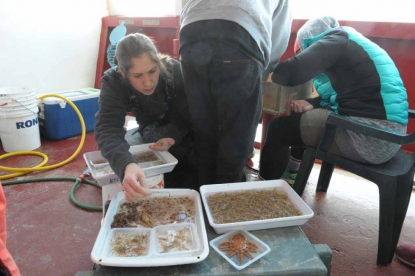 Scientists examine collected specimen (AFP / Clement Sabourin)
Scientists examine collected specimen (AFP / Clement Sabourin)For the climatologists who have come here to study polar ice, the state of affairs poses a real problem: how do you study what isn't there.
Before its current mission, the Amundsen spent several weeks in the Beaufort Sea. There too the vessel had to sail further north to find elusive ice floes.
The crew and researchers tell a harrowing tale of a mother polar bear and two cubs lost in the middle of the Arctic Ocean.
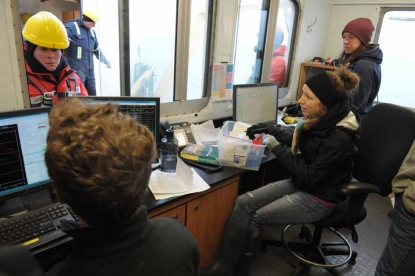 Scientists aboard monitor devices deployed in the water (AFP / Clement Sabourin)
Scientists aboard monitor devices deployed in the water (AFP / Clement Sabourin)The Amundsen came across the trio about 300 kilometers offshore, and 150 kilometers from the edge of the closest ice field. The bears swam around the vessel during the night as researchers worked, and then left.
Twelve hours later the carnivorous mammals and the Amundsen crossed paths again, this time further north.
For more than two hours the bears stalked the vessel, and the mouthwatering smells radiating from its galley.
The widely held assumption onboard is that the mother bear had taken her brood to an area she knew to be good for hunting seals, or scavenging the carcasses of narwhal, beluga and bowhead whales and walruses in order to teach them how to hunt.
Unfortunately for the bears, the ice was gone.
In this video, taken by Kathryn Purdon, a researcher at the University of Victoria in westernmost Canada, the bears can been seen trying to cut the cable attached to sensitive equipment used to collect Arctic samples.

Click here to watch this video on a mobile device
Eventually the Amundsen pulled anchor and continued on its journey, leaving the bears behind. But the encounter left the crew and passengers feeling sad.
The retreating polar ice cap and the plight of polar bears help to illustrate the impacts of global warming in the far north.
But where one era ends another begins, and that's the real focus of these adventurers headed north of the 70th parallel for a glimpse of the changes to come and the socio-political consequences they are likely to entail.
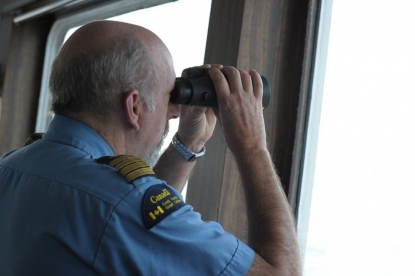 The captain of the Amundsen, Alain Lacerte (AFP / Clement Sabourin)
The captain of the Amundsen, Alain Lacerte (AFP / Clement Sabourin)Aboard the Amundsen, oceanographers, chemists, physicians, paleontologists, climatologists and others are deciphering the mysteries that await humanity beyond the "tipping point."
For them, whatever the outcome of the next round of climate talks in Paris at the end of this year, change is already upon us and the world must start planning for it.
They note that the Earth has undergone several wide temperature swings in its long history, adding that the relative climate stability of the past 10,000 to 15,000 years that allowed man to prosper was an "anomaly," says mission head Roger Francois, sporting a T-shirt on deck in minus five degrees Celsius.
But the temperature swings have never before been witnessed by man, armed with an arsenal of scientific instruments to measure all the changes, both big and small.
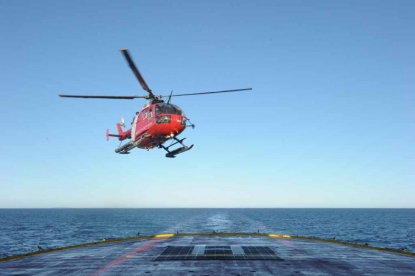 A helicopter approaches the ship (AFP / Clement Sabourin)
A helicopter approaches the ship (AFP / Clement Sabourin)Key questions remain about climate change "feedback loops" and the effect they will have on the rising temperatures -- for example melting permafrost releasing carbon emissions into the atmosphere and contributing to further warming.
How big is the real impact and is it possible to stem the cycle?
Past the 72nd parallel, we see chunks of floating ice off our bow. Now the real work begins.
Clement Sabourin is an AFP reporter based in Montreal. You can follow him on Twitter
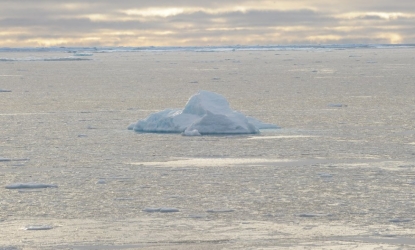 (AFP / Clement Sabourin)
(AFP / Clement Sabourin)

